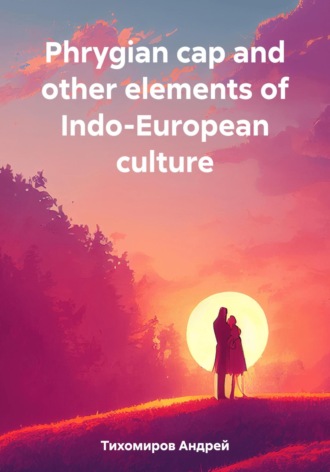
Андрей Тихомиров
Phrygian cap and other elements of Indo-European culture
The Phrygian cap is a cone-shaped headdress with the top thrown forward. Initially, the cap was worn by the Indo-European tribes of the Phrygians in Asia Minor (on the coast of Propontis near the Sea of Marmara, now the territory of Turkey), the Greeks borrowed it from them. During the French bourgeois revolution of the 18th century, the Phrygian cap became a detail of the Jacobins' clothing.
There is also a Phrygian second in music – an interval formed by the I and II steps of the Phrygian mode; lowered II degree of natural minor; Phrygian writing – a variety of Eastern Greek writing, used in the middle of the 1st millennium BC. e. the Phrygians; it differed from the Eastern Greek writing in the outlines of some letters and their somewhat different pronunciation. The monuments that have come down to us – short epigraphic texts – usually belong to the 7th-6th centuries. BC e. It was later superseded by ordinary Greek writing.
In ancient times, Phrygia was inhabited by the Indo-European people of the Phrygians, who, according to some sources, moved here from Thrace. In the period 1000-800 years. BC e. an independent early slave-owning kingdom was formed (the city of Gordius was the center), the heyday of which falls on the 7th century BC. – 1st half of the 6th c. BC e. A number of legends popular in antiquity are associated with the kings of Phrygia, Midas and Gordius. In the 6th c. BC e. Phrygia was conquered by the Lydian king Aliattes (617-560, according to Herodotus). Then Phrygia was successively subordinated to the Persian power of the Achaemenids, the empire of Alexander the Great, the kingdom of the Seleucids. In 275 BC. e. most of Phrygia was conquered by the Galatians who invaded from Europe and settled on its territory; the smaller one was attached to Pergamum a little later. In the 2nd half of the 2nd c. BC e. The Romans incorporated Phrygia into the province of Asia. The existing cult of Cybele, the “mother of the gods”, borrowed by the Greeks and Romans, was widely known.

Mag. Iran. Silver figurine VI-V centuries. BC. The World History. M., 1956, vol. II, p. 206. Magician in a Phrygian cap.

Etruscans. Female figurine from Perugia. Early 5th century BC e. State Museum. Berlin The woman is dressed in a fitted tunic that reaches her ankles and a short cloak. On her head is a conical cap resembling a Phrygian cap, her hair is braided. Kibalova L. – Gerbenova O., Lamarova M., Illustrated Encyclopedia of Fashion, Artia, printed in Czechoslovakia, 1986, p. 69.

Zarathustra. Image found in Syria (circa 3rd century AD). Zarathustra in a Phrygian cap. Zoroaster is a real historical person. He comes from a poor family, from the Spitam clan, his father's name was Purushaspa, his mother was Dugdova. His own name – Zarathushtra – in the ancient Pahlavan language (of Iranian origin, Indo-European family) can mean "possessing a golden camel" or "one who leads a camel." It should be noted that the name is quite common. It is unlikely that it belonged to a mythological hero. Zoroaster (in Russia his name is traditionally pronounced in Greek) was a professional priest, had wives and daughters. In his homeland (the region of the Southern Urals and Central Asia), the preaching of Zoroastrianism did not find recognition and was even persecuted, so Zoroaster had to flee. He found refuge with the ruler Vishtaspa (he most likely ruled in Drangiana), who adopted the faith of Zoroaster. The revelations of Zoroaster did not arise from scratch, their origins are in a religion even more ancient than Zoroastrianism. Long before the beginning of the preaching of the new creed, "discovered" by Zoroaster by the supreme God Ahura Mazda himself, the ancient Iranian tribes revered the god Mitra – the personification of the contract, Anahita – the goddess of water and fertility, Varuna – the god of war and victories, etc. Even then religious rites were formed associated with the cult of fire and the preparation by the priests of haoma for religious ceremonies. Many ceremonies, rituals and heroes belonged to the era of "Indo-Iranian unity", in which the proto-Indo-Iranians lived – the ancestors of the Iranian and Indian tribes. All these deities and mythological heroes organically entered the new religion – Zoroastrianism. Zoroaster taught that the supreme deity is Ahura Mazda (later he was called Ormuzd or Hormuzd). All other deities occupy a subordinate position in relation to him. According to scientists, the image of Ahura Mazda goes back to the supreme god of the Iranian tribes (Aryans), who was called Ahura (lord). Mitra, Varuna and others belonged to akhura. The highest akhura had the epithet Mazda (Wise). In addition to the deities Ahura, who embodied the highest moral properties, the ancient Aryans revered devas – deities of the lowest rank, who later became "wrong" deities.

Holy Three Kings. Mosaic, early 6th century. San Apollinare Nuovo, Ravenna. Italy. Kibalova L. – Gerbenova O., Lamarova M., Illustrated Encyclopedia of Fashion, Artia, printed in Czechoslovakia, 1986, p. 558. Characters in a Phrygian cap.







